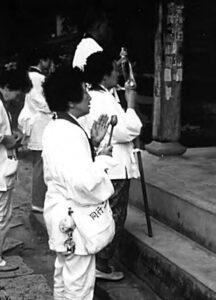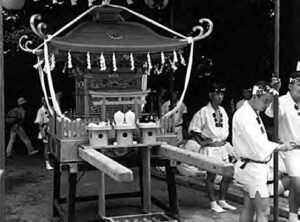by H. Byron Earhart
Looking at a course on Japanese religion (or religions) more from the perspective of the undergraduate
audience than from the professoriate persuades me that the aim of such a course should be to challenge and awaken young minds to the richness and variety —and ambiguity—of religion in Japan through its historical span and diverse manifestations.1 This enables students both to appreciate the Japanese heritage and to raise questions about the nature of a religion or tradition such that they can reflect meaningfully on their own cultural and religious backgrounds.
Perhaps the best way to acknowledge the diversity of the Japanese religious tradition and at the same time to enliven this subject matter is to view it in terms of polarities and tensions. Such balances or poles may be of either the subject matter itself or the pedagogical process.
Toward this end, I view a course and materials on Japanese religion as a balancing of a number of possibilities; each possibility contains a range of variables (poles or points of tension). The following list identifies and then briefly treats each set of possibilities.
A course on Japanese religion(s) should provide materials balancing:
UNITY/DIVERSITY—the overall pattern or configuration of Japanese religiosity, over against local, particular, and idiosyncratic examples;
SPECIFIC TRADITIONS/DIFFUSE TRADITIONS—clearly identifiable religions or traditions of thought, such as Buddhism, Shinto, and Confucianism, over against “unorganized” aspects of religion, such as patterns of belief and folk religion (shamanism);
ELITE TRADITION/COMMONERS’ TRADITION—major writers or thinkers, such as Kukai and Shinran, over against practices such as reciting darani and nembutsu by the common people;
EARLY HERITAGE/RECENT HERITAGE—not only the prehistoric over against the contemporary, but a balancing of all historical periods;
RELIGION OF MALES/RELIGION OF FEMALES—the religion of men (on which most earlier scholarship has focused) over against a growing scholarship on the religious lives of women;
RELIGION AS A CREATIVE FORCE/RELIGION AS A RESPONSE—religious ideals and practices as creating a civilization, over against religion as shaped or even determined by culture and society;
JAPANESE RELIGION AS SELF CONTAINED/JAPANESE RELIGION AS PART OF HUMAN HISTORY—Japanese religion as self-explanatory, in terms of its own historical development and systemic unity, over against Japanese religion as historically related to some traditions (such as Buddhism) and comparable to some universal themes and practices in most or all religions (such as purification);
PEDAGOGICAL APPROACH/SCHOLARLY APPROACH—stress on the delivery system, such as a computer tutorial,2 and other learning tools for conveying a consensus of previous scholarship, over against stress on presenting the cutting edge of recent scholarship;
COGNITIVE EMPHASIS/AFFECTIVE EMPHASIS—emphasis on the intellectual and critical work of analysis and understanding of key texts and scholarly treatments, over against emphasis on the more expressive and emotional activities of appreciation of religion and culture (especially in literary and aesthetic works);
INTENSIVE APPROACH through selected monographs/EXTENSIVE APPROACH through excerpted materials (in source books or anthologies)—in-depth focus on a few movements or figures or patterns, over/against briefer but comprehensive coverage of as many movements, figures, and patterns as possible.

bodhisattva Kannon in a boat with an oar in her hand, ready and willing to ferry pilgrims to a paradise free from suffering.
The above is an ambitious list of sets of ideals, and certainly no course or book can realize these ideals completely—a book as well as a course is the best combination of compromises one can come up with. Although students and professors cannot do everything, what they actually do will be better if they are aware of the possibilities and limitations of their materials and approaches—that every choice of content or process may fruitfully be understood in contrast to some alternative.
As Japan’s economic and political presence becomes even more globally conspicuous, international awareness of Japan will continue to grow. Through writing and teaching, the academy can help students and the general public go behind the moment of the present and beneath the surface appearances to encounter Japan and Japanese religiosity at a deeper level, not as some abstract essence or static ideal, but as a dynamic process along more than one axis.
1. Some of the remarks in this article were first made in a panel at the Annual Meeting of the Society for the Study of Japanese Religions, held in conjunction with the annual meeting of the Association for Asian Studies in Washington, April 8, 1995. Panel papers (and syllabi) were published as A Discussion on Teaching the Introductory Course on Japanese Religions, supplement to the October 1995 issue of the Japanese Religions Journal. I have benefited from the presentations of the other panelists, Ryuichi Abe, Karen Smeyers, and Janine Sawada, as well as from other syllabi for courses on Japanese religions included in this supplement.
2. I have developed a computer tutorial for my own textbooks and plan to make them available with the next edition.



